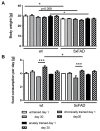Voluntary Wheel Running Did Not Alter Gene Expression in 5xfad Mice, but in Wild-Type Animals Exclusively after One-Day of Physical Activity
- PMID: 33804749
- PMCID: PMC8004053
- DOI: 10.3390/cells10030693
Voluntary Wheel Running Did Not Alter Gene Expression in 5xfad Mice, but in Wild-Type Animals Exclusively after One-Day of Physical Activity
Abstract
Physical activity is considered a promising preventive intervention to reduce the risk of developing Alzheimer's disease (AD). However, the positive effect of therapeutic administration of physical activity has not been proven conclusively yet, likely due to confounding factors such as varying activity regimens and life or disease stages. To examine the impact of different routines of physical activity in the early disease stages, we subjected young 5xFAD and wild-type mice to 1-day (acute) and 30-day (chronic) voluntary wheel running and compared them with age-matched sedentary controls. We observed a significant increase in brain lactate levels in acutely trained 5xFAD mice relative to all other experimental groups. Subsequent brain RNA-seq analysis did not reveal major differences in transcriptomic regulation between training durations in 5xFAD mice. In contrast, acute training yielded substantial gene expression changes in wild-type animals relative to their chronically trained and sedentary counterparts. The comparison of 5xFAD and wild-type mice showed the highest transcriptional differences in the chronic and sedentary groups, whereas acute training was associated with much fewer differentially expressed genes. In conclusion, our results suggest that different training durations did not affect the global transcriptome of 3-month-old 5xFAD mice, whereas acute running seemed to induce a similar transcriptional stress state in wild-type animals as already known for 5xFAD mice.
Keywords: 5xFAD; Alzheimer’s disease; acute; chronic; physical activity; wheel running.
Conflict of interest statement
The authors declare no conflict of interest. The funders had no role in the design of the study; in the collection, analyses, or interpretation of data; in the writing of the manuscript, or in the decision to publish the results.
Figures







Similar articles
-
Prolonged isolation stress accelerates the onset of Alzheimer's disease-related pathology in 5xFAD mice despite running wheels and environmental enrichment.Behav Brain Res. 2020 Feb 3;379:112366. doi: 10.1016/j.bbr.2019.112366. Epub 2019 Nov 16. Behav Brain Res. 2020. PMID: 31743728
-
Voluntary running does not reduce neuroinflammation or improve non-cognitive behavior in the 5xFAD mouse model of Alzheimer's disease.Sci Rep. 2020 Jan 28;10(1):1346. doi: 10.1038/s41598-020-58309-8. Sci Rep. 2020. PMID: 31992814 Free PMC article.
-
Can MRI T1 be used to detect early changes in 5xFAD Alzheimer's mouse brain?MAGMA. 2017 Apr;30(2):153-163. doi: 10.1007/s10334-016-0593-9. Epub 2016 Oct 26. MAGMA. 2017. PMID: 27785640 Free PMC article.
-
Sex-biased hippocampal pathology in the 5XFAD mouse model of Alzheimer's disease: A multi-omic analysis.J Comp Neurol. 2019 Feb 1;527(2):462-475. doi: 10.1002/cne.24551. Epub 2018 Nov 8. J Comp Neurol. 2019. PMID: 30291623
-
Temporal gene profiling of the 5XFAD transgenic mouse model highlights the importance of microglial activation in Alzheimer's disease.Mol Neurodegener. 2014 Sep 11;9:33. doi: 10.1186/1750-1326-9-33. Mol Neurodegener. 2014. PMID: 25213090 Free PMC article.
Cited by
-
Voluntary exercise alleviates neural functional deficits in Parkinson's disease mice by inhibiting microglial ferroptosis via SLC7A11/ALOX12 axis.NPJ Parkinsons Dis. 2025 Mar 23;11(1):55. doi: 10.1038/s41531-025-00912-5. NPJ Parkinsons Dis. 2025. PMID: 40122927 Free PMC article.
-
Multi-omics studies reveal ameliorating effects of physical exercise on neurodegenerative diseases.Front Aging Neurosci. 2022 Oct 31;14:1026688. doi: 10.3389/fnagi.2022.1026688. eCollection 2022. Front Aging Neurosci. 2022. PMID: 36389059 Free PMC article. Review.
-
GEPREP: A comprehensive data atlas of RNA-seq-based gene expression profiles of exercise responses.J Sport Health Sci. 2024 Sep 26;14:100992. doi: 10.1016/j.jshs.2024.100992. Online ahead of print. J Sport Health Sci. 2024. PMID: 39341494 Free PMC article.
-
Unpredictable disturbance and its effects on activity behavior and lifespan in Drosophila melanogaster.Biol Open. 2025 Jul 15;14(7):bio062071. doi: 10.1242/bio.062071. Epub 2025 Jul 22. Biol Open. 2025. PMID: 40554766 Free PMC article.
References
-
- Roth G.A., Abate D., Abate K.H., Abay S.M., Abbafati C., Abbasi N., Abbastabar H., Abd-Allah F., Abdela J., Abdelalim A., et al. Global, Regional, and National Age-Sex-Specific Mortality for 282 Causes of Death in 195 Countries and Territories, 1980–2017: A Systematic Analysis for the Global Burden of Disease Study 2017. Lancet. 2018;392:1736–1788. doi: 10.1016/S0140-6736(18)32203-7. - DOI - PMC - PubMed
-
- Conde-Sala J.L., Turró-Garriga O., Piñán-Hernández S., Portellano-Ortiz C., Viñas-Diez V., Gascón-Bayarri J., Reñé-Ramírez R. Effects of Anosognosia and Neuropsychiatric Symptoms on the Quality of Life of Patients with Alzheimer’s Disease: A 24-Month Follow-up Study. Int. J. Geriatr. Psychiatry. 2016;31:109–119. doi: 10.1002/gps.4298. - DOI - PubMed
-
- McKhann G., Drachman D., Folstein M., Katzman R., Price D., Stadlan E.M. Clinical Diagnosis of Alzheimer’s Disease: Report of the NINCDS-ADRDA Work Group under the Auspices of Department of Health and Human Services Task Force on Alzheimer’s Disease. Neurology. 1984;34:939–944. doi: 10.1212/WNL.34.7.939. - DOI - PubMed
Publication types
MeSH terms
Substances
LinkOut - more resources
Full Text Sources
Other Literature Sources
Molecular Biology Databases

